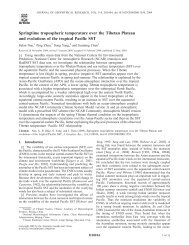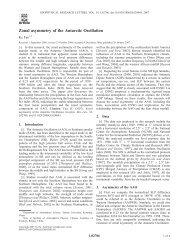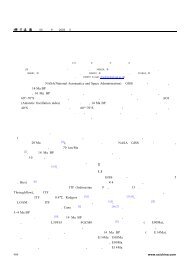Influence of the North Atlantic SST tripole on northwest African rainfall
Influence of the North Atlantic SST tripole on northwest African rainfall
Influence of the North Atlantic SST tripole on northwest African rainfall
Create successful ePaper yourself
Turn your PDF publications into a flip-book with our unique Google optimized e-Paper software.
LI ET AL.: INFLUENCE OF THE NORTH ATLANTIC <str<strong>on</strong>g>SST</str<strong>on</strong>g> TRIPOLE ACL 3 - 9<br />
Figure 8. Same as Figure 6, but for <str<strong>on</strong>g>the</str<strong>on</strong>g> 27 wettest and 22 driest late winter m<strong>on</strong>ths in <str<strong>on</strong>g>the</str<strong>on</strong>g> 1948–2000<br />
NCEP/NCAR reanalysis.<br />
to its nor<str<strong>on</strong>g>the</str<strong>on</strong>g>ast (Figure 10c), but, again, <str<strong>on</strong>g>the</str<strong>on</strong>g> NW <strong>African</strong><br />
<strong>rainfall</strong> resp<strong>on</strong>se is not significant. The negative <str<strong>on</strong>g>tripole</str<strong>on</strong>g> in<br />
late winter induces a nearly z<strong>on</strong>al regi<strong>on</strong> <str<strong>on</strong>g>of</str<strong>on</strong>g> increased<br />
<strong>rainfall</strong> al<strong>on</strong>g 35°N. In this case NW Africa is at <str<strong>on</strong>g>the</str<strong>on</strong>g><br />
sou<str<strong>on</strong>g>the</str<strong>on</strong>g>rn edge <str<strong>on</strong>g>of</str<strong>on</strong>g> this wet belt, and it has significantly more<br />
<strong>rainfall</strong>. Thus <str<strong>on</strong>g>the</str<strong>on</strong>g> simulated broad-scale <strong>rainfall</strong> resp<strong>on</strong>se to<br />
<str<strong>on</strong>g>the</str<strong>on</strong>g> <str<strong>on</strong>g>SST</str<strong>on</strong>g> <str<strong>on</strong>g>tripole</str<strong>on</strong>g> is n<strong>on</strong>linear and seas<strong>on</strong>al-dependent. Most<br />
noteworthy, however, is <str<strong>on</strong>g>the</str<strong>on</strong>g> fact that <strong>on</strong>ly <str<strong>on</strong>g>the</str<strong>on</strong>g> negative<br />
<str<strong>on</strong>g>tripole</str<strong>on</strong>g> in late winter produces a significantly more <strong>rainfall</strong><br />
over NW Africa and <strong>on</strong>ly <str<strong>on</strong>g>the</str<strong>on</strong>g> positive <str<strong>on</strong>g>tripole</str<strong>on</strong>g> in early-mid<br />
winter induces a significantly less <strong>rainfall</strong>.<br />
[26] Figure 11 shows 500 hPa geopotential height<br />
resp<strong>on</strong>ses to <str<strong>on</strong>g>the</str<strong>on</strong>g> <str<strong>on</strong>g>tripole</str<strong>on</strong>g>. These clearly exhibit an asymmetry<br />
between <str<strong>on</strong>g>the</str<strong>on</strong>g> resp<strong>on</strong>ses to <str<strong>on</strong>g>the</str<strong>on</strong>g> positive and to <str<strong>on</strong>g>the</str<strong>on</strong>g> negative<br />
<str<strong>on</strong>g>tripole</str<strong>on</strong>g>, as described by Peng et al. [2002, 2003]. In earlymid<br />
winter (Figures 11a and 11b), <str<strong>on</strong>g>the</str<strong>on</strong>g> positive <str<strong>on</strong>g>SST</str<strong>on</strong>g> <str<strong>on</strong>g>tripole</str<strong>on</strong>g><br />
induces a weak dipole over <str<strong>on</strong>g>the</str<strong>on</strong>g> eastern <str<strong>on</strong>g>North</str<strong>on</strong>g> <str<strong>on</strong>g>Atlantic</str<strong>on</strong>g>, with<br />
a positive anomaly west <str<strong>on</strong>g>of</str<strong>on</strong>g> <str<strong>on</strong>g>the</str<strong>on</strong>g> Straits <str<strong>on</strong>g>of</str<strong>on</strong>g> Gibraltar and a<br />
str<strong>on</strong>ger negative anomaly centered west <str<strong>on</strong>g>of</str<strong>on</strong>g> Britain. The<br />
500 hPa height resp<strong>on</strong>se to <str<strong>on</strong>g>the</str<strong>on</strong>g> negative <str<strong>on</strong>g>tripole</str<strong>on</strong>g> is very<br />
different, with a negative anomaly over Eastern Europe and<br />
a weak positive anomaly across <str<strong>on</strong>g>the</str<strong>on</strong>g> Sahara.<br />
[27] In late winter (Figures 11c and 11d) <str<strong>on</strong>g>the</str<strong>on</strong>g> positive<br />
<str<strong>on</strong>g>tripole</str<strong>on</strong>g> induces a wave-train-like height anomaly, with no<br />
significant resp<strong>on</strong>se over <str<strong>on</strong>g>the</str<strong>on</strong>g> Mediterranean or Africa,<br />
c<strong>on</strong>sistent with <str<strong>on</strong>g>the</str<strong>on</strong>g> absence <str<strong>on</strong>g>of</str<strong>on</strong>g> a significant rain anomaly<br />
over NW Africa (Figure 10c). In c<strong>on</strong>trast, <str<strong>on</strong>g>the</str<strong>on</strong>g> negative<br />
<str<strong>on</strong>g>tripole</str<strong>on</strong>g> induces a dipolar resp<strong>on</strong>se, with a z<strong>on</strong>ally el<strong>on</strong>gated






